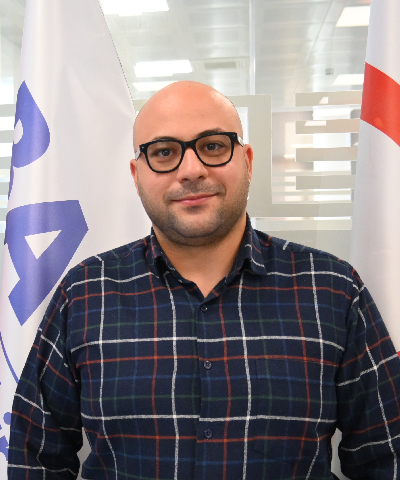A. Education
| Program |
University |
Degree |
Year |
| Computer Engineering |
Near East University |
Undergraduate |
2012 |
| Computer Engineering |
Cyprus International University |
Masters |
2015 |
| Computer Engineering |
Cyprus International University |
Ph.D |
2022 |
B. Work Experience
| Program |
Position |
University |
Period |
| Software Engineering |
Lecturer |
Bahçeşehir University |
2022-now |
| Computer Engineering |
Lecturer |
University of Kyrenia |
2021-2022 |
| Computer Engineering |
Lecturer |
Near East University |
2019-2021 |
| NEU Robotics Lab. |
Research and Development |
Near East University |
2017-2022 |
C. Administrative Positions
| Program |
Position |
University |
Period |
| Software Engineering |
Acting Head of Department |
Bahçeşehir University |
2022-now |
| Management Information Systems |
Acting Head of Department |
Bahçeşehir University |
2022-now |
D. Publications
a. Publications listed under Web of Science (SSCI veya SCI-Expanded)
- Yirtici, T., Yurtkan, K. Regional-CNN-based enhanced Turkish sign language recognition. SIViP (2022). https://doi.org/10.1007/s11760-021-02082-2
b. Conference Publications
- Akkaya N. et al. (2022) Intelligent Fuzzy System for Stray Pet Care Appliances. In: Kahraman C., Cebi S., Cevik Onar S., Oztaysi B., Tolga A.C., Sari I.U. (eds) Intelligent and Fuzzy Techniques for Emerging Conditions and Digital Transformation. INFUS 2021. Lecture Notes in Networks and Systems, vol307. Springer, Cham.https://doi.org/10.1007/978-3-030-85626-7_99
- Say, G. et al. (2022). Fuzzy Control of Mechanical Ventilation System. In: Aliev, R.A., Kacprzyk, J., Pedrycz, W., Jamshidi, M., Babanli, M., Sadikoglu, F.M. (eds) 11th International Conference on Theory and Application of Soft Computing, Computing with Words and Perceptions and Artificial Intelligence – ICSCCW-2021. ICSCCW 2021. Lecture Notes in Networks and Systems, vol 362. Springer, Cham. https://doi.org/10.1007/978-3-030-92127-9_48
- Abiyev R.H. et al. (2020) Decision Making and Obstacle Avoidance for Soccer Robots. In: Aliev R., Kacprzyk J., Pedrycz W., Jamshidi M., Babanli M., Sadikoglu F. (eds) 10th International Conference on Theory and Applicationof Soft Computing, Computing with Words and Perceptions – ICSCCW-2019. ICSCCW 2019. Advances in Intelligent Systems and Computing, vol 1095. Springer, Cham.https://doi.org/10.1007/978-3-030-35249-3_58
- Makarov P.A. et al. (2019) A Model-Free Algorithm of Moving Ball Interceptionby Holonomic Robot Using Geometric Approach. In: Chalup S., NiemuellerT., Suthakorn J., Williams MA. (eds) RoboCup 2019: Robot World Cup XXIII. RoboCup 2019. Lecture Notes in Computer Science, vol 11531. Springer, Cham. https://doi.org/10.1007/978-3-030-35699-6_13
c. Other Publications
- Mammadov, Emil & Aytac, Ersin & Türk, Ali & Akkaya, Nurullah & Say, Gorkem & Yılmaz, Berk & Bürge, Gökhan & Yirtici, Tolga & Kırgül, Ertunç. (2020). Üç boyutlu biyo-üretim: İlk izlenimlerimiz ve Çocuk Cerrahisindeki potansiyeli. Turkish Association of Pediatric Surgeons. 10.5222/JTAPS.2020.78095.
- Abiyev, Rahib Hidayat, Nurullah Akkaya, Mustafa Arici, Seyhan Huseyin, TolgaYirtici, Berk Yilmaz, Ersin and Aytac. NEUIslanders Team Description Paper RoboCup 2018. (2018).
- Abiyev, R.H., MAKAROV, P., CAGMAN, A., AYTAC, E., BURGE, G., TURK, A., AKKAYA, N., YIRTICI, T., SAY, G. and YILMAZ, B., 2019. NEUIslanders Team Description Paper RoboCup 2019. Robocup SSL, Sydney, Australia.
- ABIYEV, R.H., MAKAROV, P.A., CAGMAN, A., AYTAC, E., BURGE, G., TURK, A., AKKAYA, N., YIRTICI, T., SAY, G., YILMAZ, B. and Lefkosa, T.R.N.C., NEUIslanders Team Description Paper RoboCup 2020.
E. Research Topics
- Artificial Intelligence
- Robotics
- Machine Learning
- Neural Network
Artificial Intelligence (AI) is a field that combines computer science and robust datasets to enable problem-solving at its simplest form. AI is a very big field; thus, it has many sub-fields that even have sub-fields.
Robotics is a multidisciplinary field. Mainly consists of from engineering fields such as, software engineering, mechanical engineering, electrical engineering or biomedical engineering. Robotic devices are developed to replaces humans or replicate their actions. There are many application fields of robotics such as, military robots, medical robots, kitchen automation or educational robots.
Machine learning (ML) is an application of AI that provides systems the ability to learn and improve from experience without being explicitly programmed to do so. While AI is the broad science of mimicking human abilities, ML is a specific sub-field of AI that trains a machine how to learn. Today,
ML is mainly used for two purposes one is to make classification of data based on a model that developed. The other objective is to predict a future outcome based on the model.
In machine learning, a model is trained to make predictions on an unknown data. There are many algorithms and methods to train and test these models. Neural Networks is one of them. Using neural networks, computer vision, filtering, medical diagnosis, and speech recognition problems or tasks can be solved.
